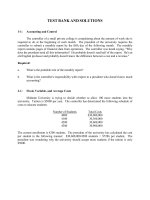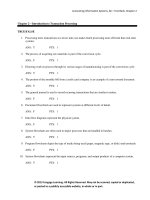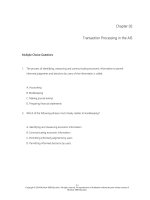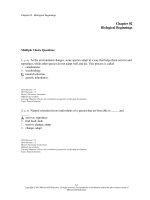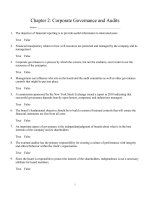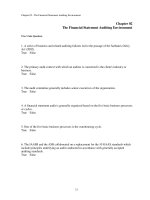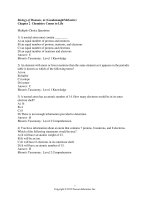Concepts of chemical dependency 8th edition doweiko test bank
Bạn đang xem bản rút gọn của tài liệu. Xem và tải ngay bản đầy đủ của tài liệu tại đây (123.82 KB, 5 trang )
Chapter 2: The Nature of the Beast
MULTIPLE CHOICE
1. Humans seem to be the only animals with a propensity towards using mind-altering substances.
a. true
b. false
ANS: B
REF: 9
2. A person may use chemicals in order to ___________.
a. cope with pain
b. bond socially
c. experience a feeling of euphoria
d. all of these answers
ANS: D
REF: 9 | 10
3. The drugs that have the highest pharmacological reward potential tend to have a ___________.
a. rapid onset of action
b. slow onset of action
c. strong social learning component
d. low probability of being addictive
ANS: A
REF: 11
4. Samantha learned that someone had given her LSD without her knowledge. Before the effects of the
drug set in, Samantha was scared of how she was going to experience the drug, as she had had a
terrifying experience in the past. Samantha’s __________ will have an impact on her physical
experience of the drug.
a. social learning
b. reward potential
c. blindness to the drug’s effects
d. expectations
ANS: D
REF: 12
5. The universally accepted definition of addiction is outlined in the DSM-IV.
a. true
b. false
ANS: B
REF: 14
6. Tolerance is defined as ___________.
a. needing to use more of a drug to achieve the desired effect.
b. continued drug abuse by an individual despite significantly negative consequences.
c. the negative physical effects the user experiences when the drug is no longer in their
system.
d. when an individual uses a compound that is not medically necessary.
ANS: A
REF: 15
7. Current research has been able to identify the causes and treatment of substance abuse disorders.
a. true
b. false
ANS: B
REF: 16
8. According to your text, the social use of a chemical:
a. is clearly inconsistent with the expectations of the person’s cultural group
b. has an inverse relationship with the person’s state of health
c. usually involves a period of intense substance abuse that is not acceptable to the leaders of the
social group
d. involves rare experimental use or its occasional use in social settings
ANS: D
REF: 10
9. According to your text, one of the rationales not associated with substance use or abuse is:
a. the person’s love relationships at the moment
b. to provide an excuse for the expression of forbidden impulses.
c. to allow the person to explore hidden realities (or at least what they interpret as hidden realities).
d. to help the user cope with physical and emotional pain.
ANS: A
REF: 10-4
10. Modern society is so infused with alcohol and drug use that we do not:
a. encourage access to sources for those compounds.
b. need much help in finding a source for these compounds.
c. expect minimal legal sanctions against those who sell and distribute drugs.
d. punish persons for their involuntary addiction-based behaviors.
ANS: B
REF: 10
11. The basic laws of behavioral psychology hold that the main motivating force for humans is the:
a. increase in comfort or decrease in discomfort.
b. pleasure principle
c. disapproval of fringe social groups
d. intrusive nature of sensory experiences deemed unacceptable to that person’s social group.
ANS: A
REF: 11
12. Sociocultural influences on an individual’s substance use behaviors:
a. are hardly relevant to the individual’s choice of drugs of abuse.
b. push individuals towards alcohol but not drug abuse.
c. help to shape the individual’s decision to engage in substance use.
d. are negative influences on the individual’s life goals.
ANS: C
REF: 11-2
13. Research cited in your text suggests:
a. The term substance abuse has been clearly defined.
b. There is little agreement about how to define use, abuse, and addiction.
c. The limits of normal use have been defined, but abuse and addiction are still ill defined.
d. The limits of both use and abuse have been clearly defined, but the term addiction is still poorly
defined.
ANS: B
REF: 10
14. The person who has a substance abuse disorder will always have that disorder, according to your text.
a. Not true! Once the person stops using the substance the condition is no longer diagnosable.
b. True, but only if the person stops abusing the chemical before the age of 25, when s/he becomes an
adult with full neurological capacity.
c. This issue has not been resolved yet.
d. Possibly, although this is only true for alcoholism and not illicit drugs.
ANS: C
REF: 14
15. Which of the following is one of the diagnostic criteria for the diagnosis of a substance use disorder,
according to your text?
a. increasing use over time
b. no avoidance of activities not centered on substance use
c. enhancement of normal functioning
d. adherence to religious dictates against substance use
ANS: A
REF: 14
16. The withdrawal syndrome seen when a compound ________ characteristic of physical dependence on that
compound.
a. is discontinued it is a
b. is discontinued is not a
c. is not used in excess is a
d. is used with decreasing frequency is not a
ANS: A
REF: 16
17. The pharmacodynamic tolerance to a compound is seen when:
a. the individual cannot predict in advance how much of that compound will be used
b. the compound induces a state of well-being when the compound is used
c. the individual is motivated to avoid compounds similar to that usually abused
d. the body adapts to the presence of drug molecules so that it might maintain normal function as
much as possible
ANS: D
REF: 15
